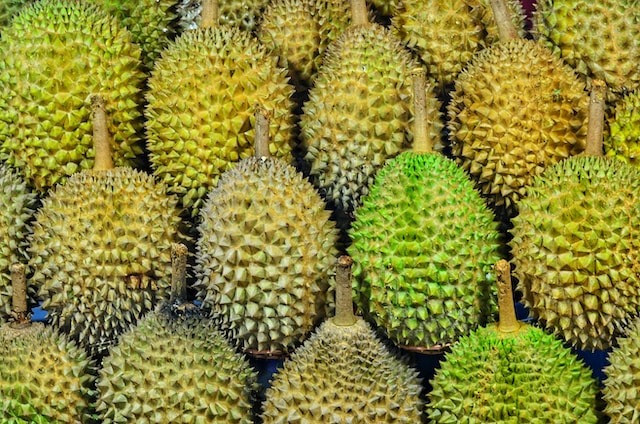W45: Durian Update

In W45 in the durian landscape, Indonesia leads the world in durian production, with 1.37 million tons produced, followed by Thailand, with 1.11 million tons of durians produced. Vietnam ranks third with 670 thousand tons. Thailand's durian is grown mainly in the Eastern provinces bordering Cambodia and the Southern regions bordering Malaysia. Chanthaburi has the most significant durian production, with farmers growing rubber, cassava, and other crops also converting to durian.
In 2022, Thailand's exports to China reached USD 4.9 billion, accounting for 96% of the market share. The Thai government is concerned about competition between Vietnamese and Philippine durians in the next five years. Malaysian durian is grown in two regions, with the Musang King variety becoming popular. Malaysia's harvesting technique is natural ripening, freezing at -180°C for 1 hour, and storing at -18°C for export. Musang King durian is four to five times more expensive in the Chinese market than Monthong durian.
Vietnam's durian growing area has grown by nearly 20% year-over-year (YoY), with the Central Highlands accounting for 40.4%. The Central Highlands has experienced the fastest increase in durian growing area, surpassing the Mekong Delta. Durian is also grown in Central Coast provinces. The durian export value reached USD 1.63 billion, with a production of 1 million tons by Sep-23. This growth has led to diverse harvest seasons across regions, emphasizing the importance for growers to strategically time harvests for optimal pricing and market competitiveness. The purchasing price of durians in the Mekong Delta region of Vietnam has risen by 50% to 60% month-on-month (MoM) due to supply difficulties meeting the Chinese market demand. High-quality Ri6 Ganyao durian has increased by USD 0.12 to 0.21/kilogram (VND 3,000 to 5,000/kg), while high-quality golden pillow durian has also seen a rise, with prices reaching USD 5.13 to 5.74/kg (VND 125,000 to 140,000/kg). Durian farmers in Tien Giang Province and Dak Lak Province have reported high prices, while traders in Can Tho City have reported supply shortages. The durian harvest season in western and central Vietnam is ending, with only a small area in Gia Lai Province still producing around 260 thousand tons.
The Philippine durian has a significant opportunity to promote Filipino flavors in the global market, particularly in China. China, the third largest durian consumer globally, is experiencing high demand, accounting for 20% of global market consumption. In 2022, China imported 824 thousand tons of fresh durian, worth USD 4 billion, with Thailand dominating the market at 95%. The Department of Agriculture (DoA), the Durian Industry Association of Davao City, and durian growers and exporters are working to ensure the quality of durian exports in China. The Philippines exported 2.3 thousand metric tons (mt) of durian in 2022, and sending 484.4 mt of durian to China, valued at USD 1.9 million for the first half of 2023.
Lastly, a Philippine durian distributor has signed a purchasing agreement with the Philippine Embassy in China for durian and papaya. The deal is part of the China International Import Export (CIIE) fair from November 5 to 10. The durian sales have grown by over 20% since 2019, and China's durian market is booming. However, China's bilateral trade turnover with the Philippines decreased by 16% YoY in the first nine months of 2023 to USD 54.1 billion, while China's import turnover with the Philippines decreased by 19% YoY to USD 14.36 billion. Malaysia, the top importer of durian, hopes to export fresh durian to China in 2024. China is expected to consume about 1 million tons of durian in 2023, but experts predict it will take many years to sustainably produce large amounts of durian.



